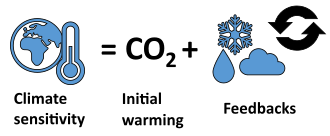
Back حساسية المناخ Arabic Sensibilitat climàtica Catalan Citlivost klimatu Czech Klimafølsomhed Danish Klimasensitivität German Κλιματική ευαισθησία Greek Sensibilidad climática Spanish حساسیت به اقلیم Persian Ilmastoherkkyys Finnish Sensibilité climatique French

Climate sensitivity is a key measure in climate science and describes how much Earth's surface will warm for a doubling in the atmospheric carbon dioxide (CO2) concentration.[1][2] Its formal definition is: "The change in the surface temperature in response to a change in the atmospheric carbon dioxide (CO2) concentration or other radiative forcing."[3]: 2223 This concept helps scientists understand the extent and magnitude of the effects of climate change.
The Earth's surface warms as a direct consequence of increased atmospheric CO2, as well as increased concentrations of other greenhouse gases such as nitrous oxide and methane. The increasing temperatures have secondary effects on the climate system. These secondary effects are called climate feedbacks. Self-reinforcing feedbacks include for example the melting of sunlight-reflecting ice as well as higher evapotranspiration. The latter effect increases average atmospheric water vapour, which is itself a greenhouse gas.
Scientists do not know exactly how strong these climate feedbacks are. Therefore, it is difficult to predict the precise amount of warming that will result from a given increase in greenhouse gas concentrations. If climate sensitivity turns out to be on the high side of scientific estimates, the Paris Agreement goal of limiting global warming to below 2 °C (3.6 °F) will be difficult to achieve.[4]
There are two main kinds of climate sensitivity: the transient climate response is the initial rise in global temperature when CO2 levels double, and the equilibrium climate sensitivity is the larger long-term temperature increase after the planet adjusts to the doubling. Climate sensitivity is estimated by several methods: looking directly at temperature and greenhouse gas concentrations since the Industrial Revolution began around the 1750s, using indirect measurements from the Earth's distant past, and simulating the climate.
- ^ "What is 'climate sensitivity'?". Met Office. Archived from the original on 7 May 2019. Retrieved 14 February 2020.
- ^ "Climate sensitivity: fact sheet" (PDF). Australian government. Department of the Environment. Archived (PDF) from the original on 12 February 2020. Retrieved 12 February 2020.
- ^ IPCC, 2021: Annex VII: Glossary [Matthews, J.B.R., V. Möller, R. van Diemen, J.S. Fuglestvedt, V. Masson-Delmotte, C. Méndez, S. Semenov, A. Reisinger (eds.)]. In Climate Change 2021: The Physical Science Basis. Contribution of Working Group I to the Sixth Assessment Report of the Intergovernmental Panel on Climate Change [Masson-Delmotte, V., P. Zhai, A. Pirani, S.L. Connors, C. Péan, S. Berger, N. Caud, Y. Chen, L. Goldfarb, M.I. Gomis, M. Huang, K. Leitzell, E. Lonnoy, J.B.R. Matthews, T.K. Maycock, T. Waterfield, O. Yelekçi, R. Yu, and B. Zhou (eds.)]. Cambridge University Press, Cambridge, United Kingdom and New York, NY, USA, pp. 2215–2256, doi:10.1017/9781009157896.022.
- ^ Cite error: The named reference
:5was invoked but never defined (see the help page).
© MMXXIII Rich X Search. We shall prevail. All rights reserved. Rich X Search